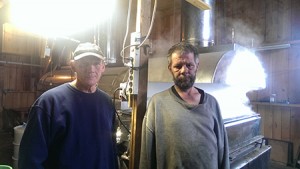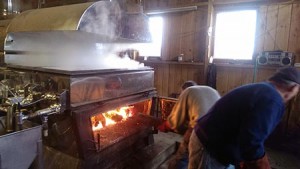

copyright the Chronicle April 29, 2015
by Elizabeth Trail
Alfred Carrier and his son Alfred Carrier Jr., were among the last people in Orleans County still making maple syrup this past weekend. Many local sugarmakers report that they quit boiling early last week.
Local sugarmakers say the season was nothing to brag about. While some made close to a regular crop, others said they made about half as much as normal. Sugarmakers who do not use vacuum had a particularly skimpy crop.
Asked how her season was, Janet Osborne in Island Pond said, “Horrid.”
The Carriers’ 8,000-tap sugarbush sits high and cold on a north slope above their house, near the top of Dexter Mountain Road. And that location probably has something to do with the fact that they didn’t do as badly as some.
“I didn’t know what we’d get today,” said the older Mr. Carrier Saturday afternoon.
Running their reverse osmosis equipment at only 3 percent, the sap boiled cleanly and without foaming. Although the Carriers have two extra six-foot stainless steel pans, which they keep cleaned and ready to use in case one of the pans they are using foams up and starts to stick, Saturday’s boiling went so smoothly that they never even had to change pans.
The Carriers said at first that they had a poor to middling year. However, they brightened when they crunched the numbers and realized that, as of Saturday, they had made 43 barrels of syrup — over two-thirds of the 62 barrels they made in their best year. The Carriers use both plastic 44-gallon barrels and stainless steel 40-gallon barrels.
“If we get a couple more days cold like today, we could boil another few days,” said Mr. Carrier senior.
After a lifetime of helping friends sugar, the family built its own sugarhouse seven years ago. Their shiny stainless steel rig can produce 200 gallons of syrup an hour.
“If we have good wood and we push it,” said the younger Mr. Carrier.
“We never got any big runs,” said the elder Mr. Carrier. “Good runs, but not big ones.” They started tapping in mid-January, but didn’t start sugaring until March 27.
“We made two drums, then we waited and waited and waited,” said his son. The family didn’t get to start sugaring seriously until well into April.
Over in Westfield, Jacques and Pauline Couture’s 7,500-tap sugarbush is about as different from the Carriers’ as it could be. It sits on a south and east-facing slope, making it what sugarmakers call an “early bush.” The highest elevation is around 1,200 feet.
The Coutures started sugaring late, around March 28, and finished on April 20.
“It was a very short season,” Mr. Couture said. “We got about half of normal.”
He was pleased with the overall quality of his syrup, however.
“It was very good. We got lots of light and mild, not much dark and robust,” Mr. Couture said, using the new maple grading terminology.
Until recently, “light and mild” was called “fancy,” while “dark and robust” appeals to people who formerly looked for the stronger flavors of “grade A dark amber” and “grade B.”
Mr. Couture was philosophical about the poor sugaring season.
“We’re farmers, he said. “We’ve had worse years than this one, and we’ve had better ones, but life goes on.”
“We’re on our sixth year and it was horrid,” Ms. Osborne said. “We got 650 gallons and the last hundred gallons we can’t sell to our customers.”
“Usually late season, the syrup gets dark,” Ms. Osborne said. “This was the strangest thing I’ve ever seen. It was pale, pale yellow, but it wouldn’t filter, and it was thick, like honey. I don’t know what we’ll do with it, maybe sell it to someone who just wants to use it as a sweetener. It is sweet.”
Since the death of her husband, Ms. Osborne sugars with her sons. In its best year, Osborne Family Maple made 1,400 gallons of syrup.
“Our trees are dripping today,” Ms. Osborne said, “but there’s no point in boiling if you can’t filter it.”
The Osborne sugarbush is another cold bush, high and facing north. There were many days during the sugaring season, Ms. Osborne said, when the sap was running but the lines were frozen. Even though they have a vacuum, the sap wouldn’t move through the lines until around 3 p.m, when the day, for all practical purposes, was over.
“I hope we don’t have many more seasons like this,” Ms. Osborne said. “You buy all the equipment and then you have bills to pay.”
Frances and Helene Taylor finished boiling last Tuesday. They sugar in Glover.
“It wasn’t a good year,” Ms. Taylor said. ‘’Probably a little better than half. The quality was there, but not the quantity.”
“I think the reason we got what we did is that most of our sugarbush is high and on a north slope. We had about four feet of snow around the base of the trees. That held it for longer.”

“We didn’t even get a January thaw,” Ms. Taylor said. “We had those couple of days in February, but it wasn’t enough to make the sap run. The old-timers say that for every thaw you get a run, but it didn’t happen this year.”
The Taylors, who bought a new sugarbush in 2009, and built a new sugarhouse with a pipeline system and vacuum equipment three years ago, still have a small number of trees on buckets. There was a huge difference between the trees that were on buckets and the trees on pipeline, Ms. Taylor said.
“We hardly got anything out of the buckets,” she said.
Eric Lanou used to make a lot more syrup. Since having a heart attack a few years ago, he downsized to a backyard operation. He said he made five gallons from 17 taps this year, or less than a third of a gallon per tap.
“But the taste was really excellent.”
Henry Marckres, the maple specialist at the Agency of Agriculture in Montpelier, said in a telephone interview that the state as a whole had a good year. However, he estimated maple production in the Northeast Kingdom at about 75 percent of the usual amount.
Mr. Marckres is originally from Craftsbury and knows most of the sugarmakers in the area.
“My general impression is that people using gravity or buckets didn’t do well,” he said. “Most of the people who have vacuum systems did better.”
From what Mr. Marckres had heard, the lay of the various sugarbushes was also significant this year due to the persistent cold late into the season.
“It appears that south- or west-facing sugarbushes might have done a little better,” he said.
Matt Gordon is the executive director of the Vermont Maple Sugar Makers’ Association. Over the telephone, Mr. Gordon said that, overall, the sugaring season in Vermont was good, despite a slow start.
“Most people got close to what they wanted, and the quality was really good,” he said. “They got the sweetness and they got the flavor. However, the Northeast Kingdom may have been a little less.”
Mr. Gordon said that to his knowledge, nearly everyone had finished sugaring around the state.
“Overall, it sounds like it was a pretty good year, especially in southern and central Vermont,” said Brian Stowe, sugaring operations manager at the University of Vermont’s Proctor Maple Research Center in Underhill Center, which is both a research facility and a working sugarbush.
In addition to running the actual sugaring operation, Mr. Stowe designs some of the studies done at the research center and collects data for a variety of projects. In the course of his work, he talks to sugarmakers from all over the state.
“I’m hearing that quantities were about average,” Mr. Stowe said over the phone. “Overall flavor was good, and quite a lot of light grade.”
The Proctor Maple Research Center has 3,650 taps. They tapped later than usual this year, around Town Meeting Day, which used to be traditional in the days before vacuum systems. In those days, tapping had to be perfectly timed. Too late and the sugarmaker might miss a sap run. Too early and the tree would have time to start to regrow, clogging the tap.
“It was just too cold this year to tap in January,” Mr. Stowe said. “Too cold to be safe for the people who had to be out in it.”
Now that pipelines and vacuum pumps are used, the window of time between drilling and tapping the tree and having to worry about regrowth is much longer, so sugarmakers have the luxury of tapping earlier to take advantage of brief early season thaws.
“You definitely get less regrowth with the sealed system,” Mr. Stowe said. “Also, sometimes you can pull up sap with the vacuum and it gets things going, helps the trees to wake up a little.”
Mr. Stowe described the year as similar to some he remembered growing up in the 1960s and ’70s — lots of snow and a late cold season. The Proctor Center got a light sap flow on March 10, then a five-day break, then the sap ran pretty steady until they finished sugaring on April 16, Mr. Stowe said.
“We didn’t get any huge runs, but we ended up with over a half-gallon per tap,” he said.
Jed’s Maple in Derby has a south-facing sugarbush, all on a vacuum system. Owner Steve Wheeler reported over the phone that he had a very good year.
“We’re not a high elevation bush, but we’re not a low one either,” Mr. Wheeler said. “It was a late spring, but when the woods woke up, they woke up quickly.”
With 4,000 taps, Jed’s Maple finished within 100 gallons of the goal Mr. Wheeler says he set for himself before the season began. He stopped boiling last Thursday, but is already gearing up for a new venture — making birch syrup.
“It’s a natural thing to do,” Mr. Wheeler said. “It uses the same equipment, and it starts up after the maple season is over.”
For more free articles from the Chronicle like this one, see our Editor’s Picks pages. For all the Chronicle’s stories, subscribe:
Print subscription
Annual online subscription
Short-term online subscription







